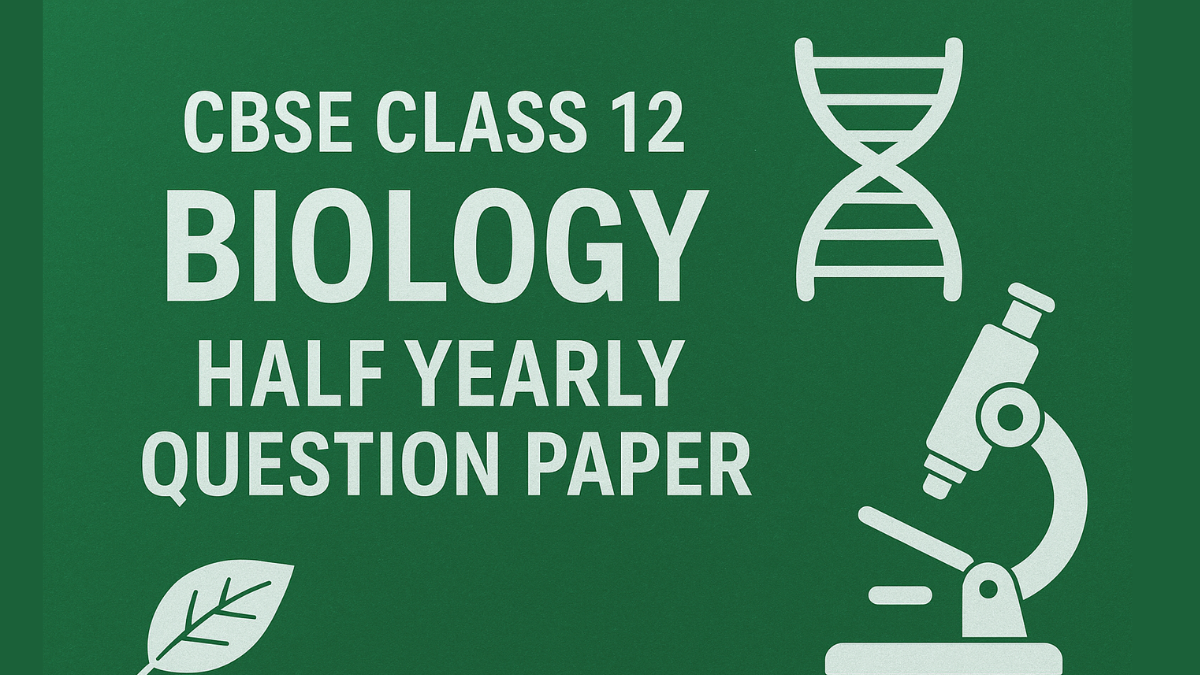As we are in the middle of the 2025-26 academic year, most of the CBSE-affiliated schools have started the mid or half-yearly examination in the month of September 2025. Biology is one of the most crucial subjects in class 12th for Science stream students. As these half-yearly exams are held at the school level, the Class 12 Biology Half Yearly Question paper 2025-26 varies from school to school as per their syllabus completion. On the other hand, the central board does not release any official half-yearly question papers for the public. For the students who are looking for the CBSE Class 12 Biology Half Yearly Question paper 2025-26 as a practice resource, they might refer to the CBSE official biology sample paper for the same. To help students, we have shared the most expected CBSE Class 12 Biology Half Yearly Sample Question paper with Solutions on this page.
CBSE Class 12 Biology Half Yearly Question Paper 2025-26
All the students who are planning to appear in the NEET UG Examination must carefully prepare the biology section, as this section includes 50% of the total NEET score. These half-yearly exams. The CBSE Mid Term Exams are extremely important in every student’s academic path because they not only assess half-yearly progress but also aid in creating confidence for final exams. The CBSE Class 12th Biology Syllabus includes several topics, including Reproduction, Genetics and Evolution, Biology and Human Welfare, Biotechnology and Its Applications, Ecology and Environment.
The CBSE Class 12 Biology Half Yearly Question Paper is completely prepared based on the official syllabus. It is very important to master all the topics. Below is the CBSE Class 12th Biology Chapter-wise weightage for effective preparation.
| Unit | Chapter | Weightage |
| Unit VI: Reproduction | Sexual Reproduction in Flowering Plants | 7 marks |
| Human Reproduction | 6 marks | |
| Reproductive Health | 3 marks | |
| Total | 16 marks | |
| Unit VII: Genetics and Evolution | Principles of Inheritance and Variation | 8 marks |
|
Molecular Basis of Inheritance
|
8 marks | |
| Evolution | 4 marks | |
| Total | 20 marks | |
|
Unit VIII: Biology and Human Welfare
|
Human Health and Diseases | 9 marks |
|
Microbes in Human Welfare
|
3 marks | |
| Total | 12 marks | |
|
Unit IX: Biotechnology and Its Applications
|
Biotechnology – Principles and Processes | 6 marks |
|
Biotechnology and Its Applications
|
6 marks | |
| Total | 12 marks | |
|
Unit X: Ecology and Environment
|
Organisms and Populations | 5 marks |
| Ecosystem | 3 marks | |
|
Biodiversity and Its Conservation
|
2 marks | |
| Total | 10 marks |
Class 12 Biology Mid Term Question Paper Pattern
As the aim of the CBSE Class 12th Biology mid-term question paper is to make students aware of their final board exam preparation, the paper pattern will be the same. These allow students to get familiar wth the real exam level questions, their types, marking scheme, and help them make an effective question paper approach plan.
- The total marks for the CBSE Class 12th Half-yearly Biology question paper is 70 marks.
- All the students are required to answer the compulsory. question as instructed within a three-hour of time frame.
- The Midterm half-yearly question paper has five sections and 33 questions. Take a look at the section-by-section question paper pattern below.
- Section A has 16 questions of 1 mark each.
- Section B has 5 questions of 2marks each;
- Section C has 7 questions of 3 marks each.
- Section D has 2 case-based questions of 4 marks each
- Section E has 3 questions of 5 marks each.
It should also be noted that there is no overall choice. However, internal choices have been provided in some questions. A student has to attempt only one of the alternatives in such questions. Wherever necessary, neat and properly labelled diagrams should be drawn.
CBSE Class 12 Biology Half Yearly Sample Paper 2025-26 with Answers
| Section A ( 16 Q x 1 mark = 16 marks) |
1. Signals for parturition in human female originate from
A. Fully developed foetus only
B. Both placenta as well as fully developed foetus
C. Placenta only
D. Oxytocin released from maternal pituitary
Answer: B. Both placenta as well as fully developed foetus
2 To produce 1600 seeds, the number of meiotic divisions required will be
A. 2400
B. 2000
C. 1600
D. 1800
Answer: B. 2000
3. A sample of normal double-stranded DNA was found to have thyminecontent of 27%. What will be the expected proportion of guanine in this strand?
A. 23%
B. 32%
C. 36%
D. 73%
Answer: A. 23%
Explanation:* If T = 27%, then A = 27% (A pairs with T). Remaining G + C = 100 − 54 = 46%, so G = 46/2 = **23%
4. E. coli has 4.6 X 10 6 base pairs and completes the process of replication in 18 minutes, then the average rate of polymerization is approximately
A. 2000 bp/s
B. 4000 bp/s
C. 3000 bp/s
D. 1000 bp/s
Answer: A. 2000 bp/s
5. The experimental proof on the thermal stability of genetic material was first provided by experiments of
A. Hershey and Chase
B. Meselson and Stahl
C. Frederick Griffith
D. Jacob an Monod
Answer: C. Frederick Griffith
6. Short stretches of DNA used to identify complementary sequences in a
sample are called
A. Probes
B. Markers
C. Primers
D. Minisatellites
Answer: A. Probes
7 Which of the following features shows the mechanism of sex
determination in honey-bee?
(i) An offspring formed from the union of a sperm and egg develops as a female.
(ii) Males have half the number of chromosomes than that of female.
(iii) The males are haploid having 32 chromosomes.
(iv) All workers and males are diploid having 16 chromosomes
A. (i) and (ii)
B. (ii) and (iii)
C. (i) and (iv)
D. (ii) and (iv)
Answer: A. (i) and (ii)
Explanation: Honeybee sex determination is haplodiploid: fertilized (sperm + egg) → female; males are haploid and have half the chromosome number — (i) and (ii) are correct.
8 The following diagram shows a fragment of DNA which is going to be transcribed, the upper strand with polarity 3’ to 5’ is the template strand:
3´ ATTGCC 5´
5´ TAACGG 3´
After transcription the mRNA can be represented by:
A. 5´ AUUGCC 3´
B. 5´ AUUGCC 3’
C. 5´ UAACGG 3´
D. 5´ GGCAAU 3´
Answer: C. 5´ UAACGG 3´
Explanation:* Template (3′→5′) = 3′ ATTGCC 5′. mRNA (5′→3′) is the complement with U replacing T → **5′ UAACGG 3′.
9. Select the incorrect statement among the following.
A. p²+2pq+q2 = 1. This is binomial expansion of (p+q)2
B. When frequency measured differs from expected values, the difference (direction) indicates the extent of evolutionary change.
C. Hardy-Weinberg principle says that phenotype frequencies in a population are stable and are constant from generation to
generation.
D. The gene pool (total genes and their alleles in a population) remains constant. This is called genetic equilibrium. Sum total of
all the allelic frequencies is 1.
Answer: C. Hardy-Weinberg principle says that phenotype frequencies in a population are stable…
10 Adaptive radiation leads to which of the following?
A. Increased competition among species
B. Decreased speciation rates
C. Limited morphological diversity among species
D. Rapid divergence of traits among populations inhabiting a given geographical area.
Answer: D. Rapid divergence of traits among populations inhabiting a given geographical area.
Question No. 13 to 16 consist of two statements – Assertion (A) and Reason (R). Answer these questions selecting the appropriate option given below:
A. Both A and R are true and R is the correct explanation of A.
B. Both A and R are true and R is not the correct explanation of A.
C. A is true but R is false.
D. A is False but R is true.
13 Assertion (A): Cells of tapetum have more than one nucleus.
Reason (R): They undergo meiosis without cytokinesis.
Answer: C. A is true but R is false.
14 Assertion (A): Deoxyribonucleoside triphosphates serve dual purposes.
Reason (R): They act as proofreaders and provide energy.
Answer: C. A is true but R is false.
15 Assertion (A): A floating cover placed over the slurry in a biogas plant keeps on rising.
Reason (R): This cover keeps on rising due to the gas produced in the tank by the microbial activity.
Answer: A. Both A and R are true and R is the correct explanation of A.
16 Assertion (A): DNA fragments can be isolated by Gel electrophoresis on the basis of their size.
Reason (R): The larger the fragment size, the faster it moves
Answer: C. A is true but R is false.
The rest of the Questions and answers of Sections B, C, D & E will be updated soon.










 CBSE Admit Card 2026 for Private & R...
CBSE Admit Card 2026 for Private & R...
 AILET 2026 AIR 1: Check Full Toppers Lis...
AILET 2026 AIR 1: Check Full Toppers Lis...
 AILET Result 2026 OUT, How to Download S...
AILET Result 2026 OUT, How to Download S...








